Want to know how to make your tap water taste better? Our team of water treatment experts has been committed to improving the taste, smell, and overall quality of our water for decades, and here, we’ve shared our top 7 methods for improving the taste of your tap water.
| Method | Solution | Best For |
|---|---|---|
| Water Treatment Systems | Air Injection, Activated Carbon, KDF-55 Filters, Reverse Osmosis, and Water Softeners | Significant taste improvement & contaminant removal |
| Fruit & Herb Infusion | Ginger & Lemon, Lime & Mint, Apple & Cinnamon, etc. | Subtle flavor enhancement & variety |
| Alkalize Water with Minerals | Alkaline Water Filter Pitchers, Trace Mineral Drops | Increase pH & add healthy minerals |
| Add Ice | Plain ice cubes, Frozen fruit/herb ice cubes | Improve coldness & add subtle flavors |
| Flush/Replace Plumbing | Flush pipes (sediment, algae), Replace pipes (corrosion) | Eliminate metallic taste from old pipes |
| Add Some Fizz | Carbonated Water Treatment Machine/Faucet | Prefer sparkling water |
| Leave Water to Sit/Boil | Leave open for 24 hours (chlorine evaporates), Boil for 15 minutes (faster chlorine removal) | Remove chlorine taste & smell |

❔ Why Does Tap Water Taste Bad?
Before we look at how to make tap water taste better, let’s consider the reasons why tap water tastes bad.
In our own experience, we’ve found that some of the most common causes of the bad tastes in tap water, and the reasons for these tastes, are:
- Chemical Taste – Chlorine Disinfection: If your tap water has a chemical or chlorine taste, it’s most likely due to chlorine disinfection. All public water supplies are disinfected with chlorine or chloramine to prevent microbiological contamination. Chlorinated water is safe to drink, but it usually has an unpleasant taste and smell.
- Rotten Egg Taste – Hydrogen Sulfide – We’ve found that hydrogen sulfide is the most common cause of rotten egg taste and odor in water. Private groundwater wells are especially prone to high hydrogen sulfide levels in the water.
- Metallic Taste – Iron – Metallic-tasting water is usually caused by metals, like iron, manganese, and zinc. These contaminants also give water a rusty color and may leave orange, red, or black stains on your water-using appliances and fixtures.
- Dirty or Musty Taste – Sediment and Algae – Musty or dirty-smelling tap water is typically caused by sediment or algal blooms in your source water, and is typically a problem in private wells. Alongside the poor taste, you may notice that your water has a brownish tinge or doesn’t look crystal clear.
- Bitter Taste – Copper – Tap water that tastes bitter or medicinal is typically caused by copper. Copper gets into water through the corrosion of pipes and plumbing. You might also notice green or blue stains on fixtures and around your faucets.
Related: Why does my water taste like plastic?
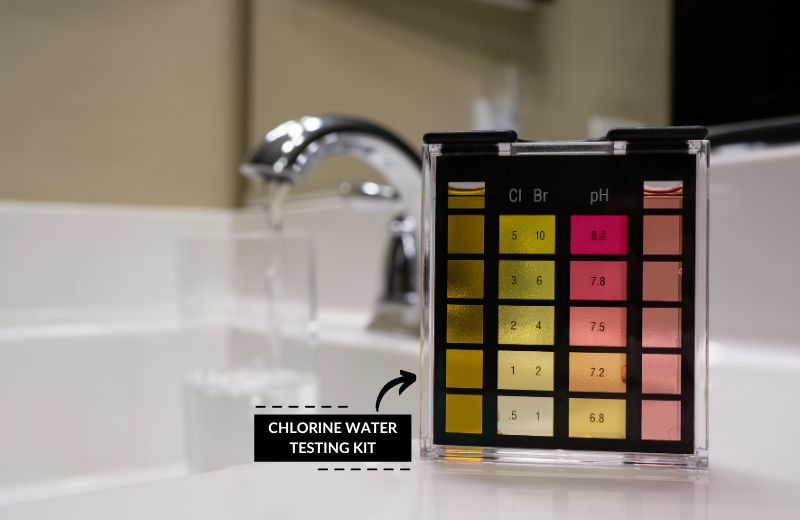
📝 7 Ways to Make Tap Water Taste Better
Here are our top 7 tried-and-tested methods to improve the taste of your tap water at home.
Method #1: Use a Water Treatment System
Our own experience tells us that the best way to significantly improve your tap water’s taste is to buy a water filter system that can remove the contaminants causing the bad taste or smell.
Some of the best water treatment systems to consider are:
- Air Injection Filtration (For Metallic and Rotten Egg Taste) – An air injection filtration system is the best solution for water that contains eggy-smelling hydrogen sulfide. This system oxidizes iron, manganese, and sulfur, then traps the oxidized contaminants in a greensand media. Using an air injection filter means you can eliminate rotten egg tastes and smells from your entire home’s water supply.
- Activated Carbon Filtration (For Chlorine Taste) – Filtering tap water with an activated carbon filter is the best way to get rid of a chlorine or chemical taste. Activated carbon filters adsorb chemicals like chlorine, pulling them out of the water. Some of the best activated carbon water filters are NSF certified for their ability to remove chlorine smell and taste. You can use a simple activated carbon filter, like a water filter pitcher, to remove the unpleasant taste of chlorine from your drinking water.
- KDF-55 Filters (For Metallic or Bitter Taste) – Filtering tap water with KDF filter media should reduce some of the most common heavy metals, including copper, mercury, and nickel, removing any bitter or metallic tastes from your drinking water. KDF-55 also removes dangerous metals that don’t have a taste or smell, like lead.
- Reverse Osmosis System (For All Tastes and Odors) – A reverse osmosis system is the best water treatment method for addressing all contaminants that could make tap water taste unpleasant. The RO purification process involves sending water through a semi-permeable membrane, with tiny pores that allow only water molecules to pass through. Treating your water in a reverse osmosis system should eliminate everything that could give your water a bitter, chemical, eggy, or metallic taste. You might want to remineralize your RO water too, learn more about that here.
- Water Softeners (For Hard Water Tastes) – Water softeners are whole-house water treatment systems that remove calcium and magnesium ions. These minerals are responsible for hard water, which has a taste that many folks find unpleasant. Removing these minerals with a water softener means you can enjoy limescale-free tap water with an improved taste.
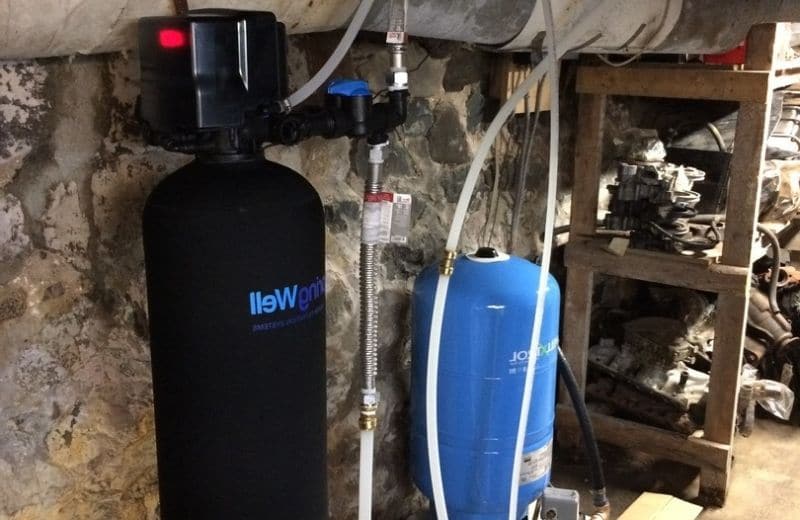
Method #2: Infuse your Water With Fruit & Herbs
If your water doesn’t have a strong taste of chemicals or metals, but you still don’t enjoy the taste of plain tap water, try infusing it with fruit or herbs.
Rather than buying bottled mineral water (which is wasteful and expensive), add your ingredients of choice to a pitcher or glass to make your tap water taste better instantly.
There are a multitude of different water infusion combinations. Some of our favorite options are:
- Ginger and lemon
- Lime juice, mint, and cucumber
- Apple and cinnamon
- Strawberries
- Lemon and lime
To overpower particularly noticeable tastes or smells, go for cucumber. It packs a strong flavor punch and is super healthy, too.
If you don’t have the time or patience to infuse your tap water with actual fruits and vegetables, consider using low-sugar fruit cordial instead. Add a small amount to your water to introduce an enjoyable fruity flavor.
Related: Is MiO Bad for You?
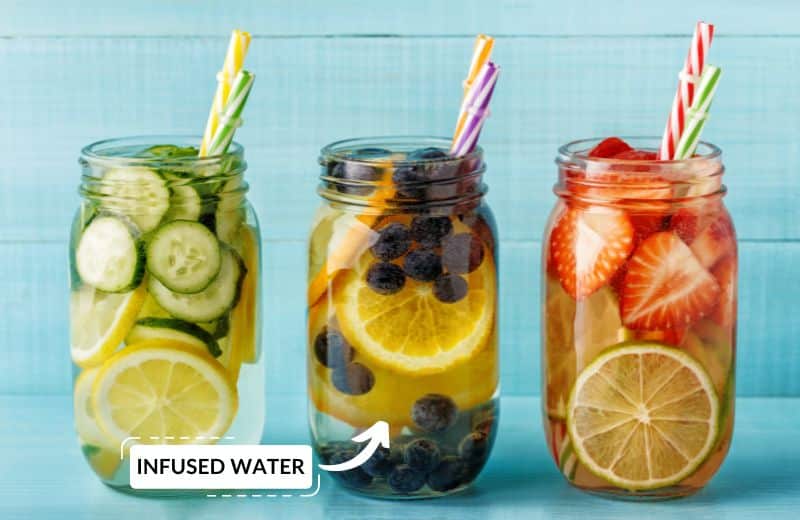
Method #3: Alkalize your Water with Minerals
A key reason why bottled water often tastes nicer than tap water is because it contains healthy minerals and has a higher pH.
One of the simplest ways to increase the pH of your water and add healthy minerals is to use an alkaline water filter pitcher. This type of pitcher removes taste-and-smell-affecting contaminants, like chlorine, and releases healthy minerals that further improve tap water taste.
Alkaline water filter pitchers are easy to use and maintain. You just fill the pitcher with water and wait for it to filter into the bottom chamber. Filters typically need replacing every three months or so.
Related Content: Find out more about the best alkalizing water filter pitchers in this guide.
If you don’t want to invest in a water filter pitcher, you can also use trace mineral drops to boost your water’s pH and mineral content without the added benefits of filtration. You just add a few drops to a large glass of tap water for instant effects.
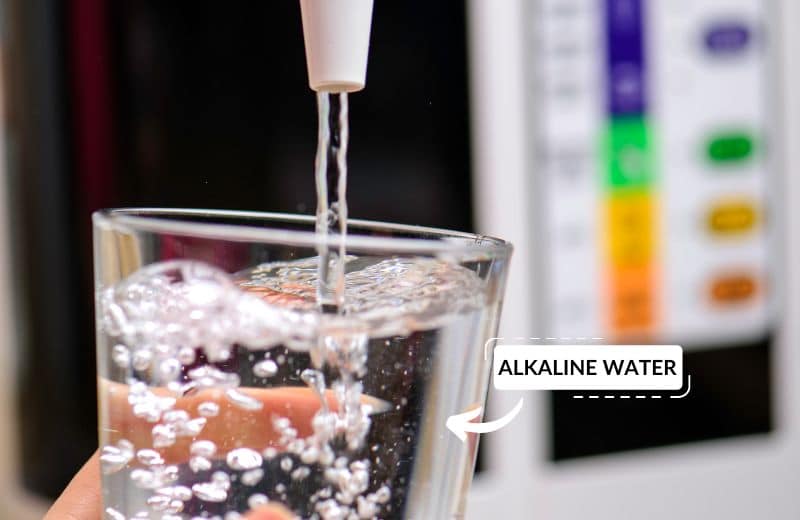
Method #4: Add Ice
Some folks find ice water more appealing than plain tap water. We think that water tastes less enjoyable if it’s warm – if you’ve ever sipped from a water bottle that’s been left in a hot car, you’ll know how unpleasant it can be.
Making your tap water taste better could be as simple as adding ice cubes. To make things even more interesting, add fruits and herbs to the water in your ice cube trays, then freeze them. You’ll have ice-cold water that tastes sweet and exciting.
Method #5: Flush Or Replace Your Plumbing
If you’ve noticed a metallic water taste, it might be coming from your plumbing materials. This is especially likely if you live in an old property.
In this case, you can permanently banish this source of contamination by flushing or replacing your pipes. Flushing your pipes should remove sediment buildup, and moss and algae growth, but if your plumbing has deteriorated as a result of corrosion, you’ll probably need to think about investing in replacement pipes.
Method #6: Add Some Fizz
You might be someone who prefers sparkling water to still water. In this case, a simple way to make your tap water taste better is to add some fizz.
There are water treatment machines and faucets available to buy that deliver carbonated tap water on demand. So don’t waste your money on expensive bottles of sparkling water at the store. You can convert your own drinking tap water into sparkling water at home.
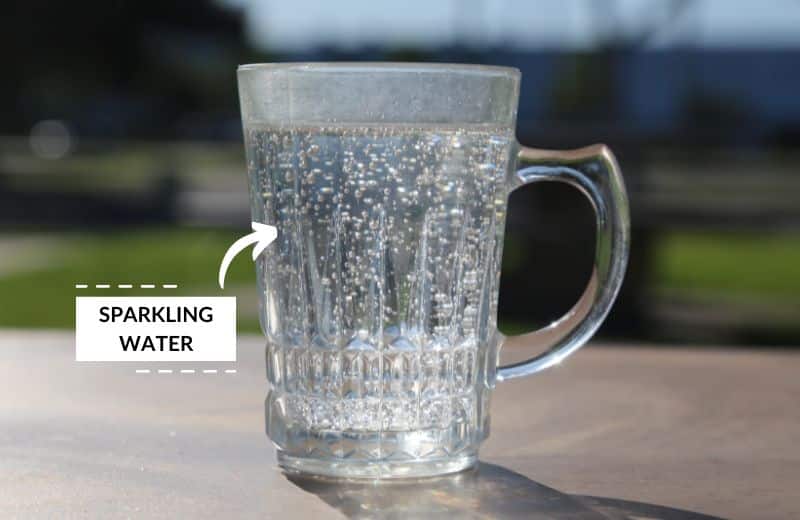
Method #7: Leave The Water to Sit for a Bit
Chlorine, one of the most common contaminants affecting tap water quality, taste, and smell, will gradually evaporate from standing water that’s exposed to air. If you leave chlorinated water in a jug in your fridge, all the chlorine should evaporate within 24 hours, eliminating associated poor tastes and odors.
You can speed up the chlorine evaporation process by boiling your water. Leaving a pot of water on a rolling boil for 15 minutes should cause all the chlorine to evaporate.

